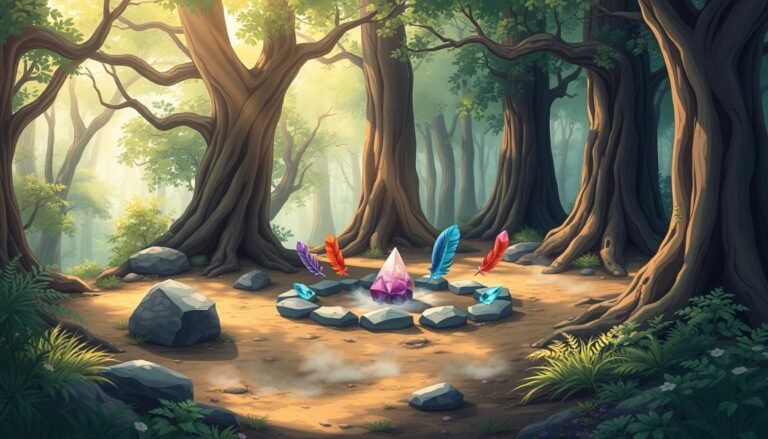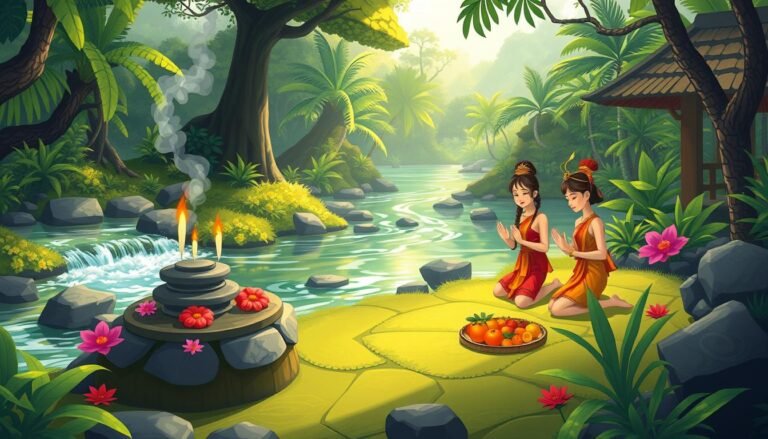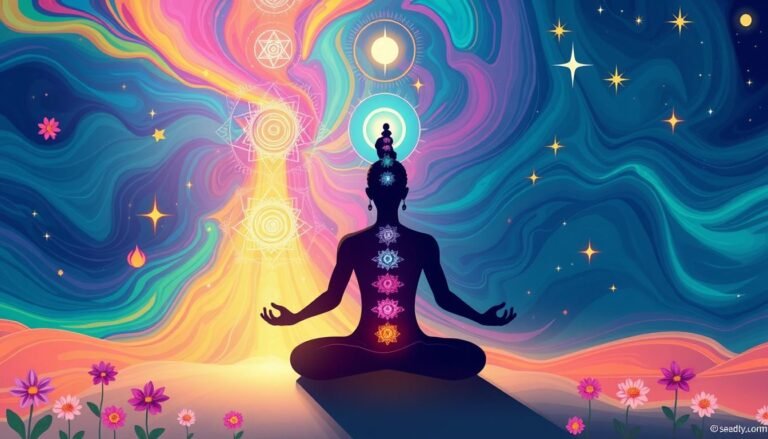How Does Daoism Teach Inner Peace?
“The Tao that can be told is not the eternal Tao.” – Lao Tzu
This quote from the Tao Te Ching introduces us to Daoism and inner peace. Daoism is a key part of Chinese philosophy. It guides us to spiritual enlightenment and harmony with the universe.
Daoism began in the 3rd century B.C.E. It teaches that we can find the Tao by ourselves. This wisdom says true peace comes from living in harmony with life’s natural flow.
The Daoist way to peace involves three steps. First, let go of what you think the Tao is. Then, understand Daoist philosophy. Finally, accept yourself fully. This path uses ideas like effortless action and naturalness to help us face life’s challenges.
As we explore Daoism, we’ll see how it helps us find peace in today’s world. Let’s start this journey to learn Daoism’s secrets of inner peace.
Understanding the Fundamentals of Daoism
Daoism is a philosophy from ancient China. It teaches us to live in harmony with nature and ourselves. This belief system started in the 6th century BCE, during a time of trouble in China.
The Concept of Tao (The Way)
At the heart of Daoism is the concept of Tao, or “The Way.” Lao Tzu, the founder, saw Tao as the natural order of the universe. It is the source of all things and the balance between being and non-being.
Key Principles of Daoist Philosophy
Daoist philosophy teaches us to live in harmony with nature. It values simplicity, gentleness, and harmony. A key idea is wu wei, or “non-action,” which means moving with life’s flow, not against it.
“The softest thing in the universe overcomes the hardest thing in the universe.” – Lao Tzu
Historical Context and Development
Daoism grew during the Warring States period in China. The Daodejing, credited to Lao Tzu, is its key text. Daoism has shaped Chinese culture, governance, and spirituality. It reached its peak in the Tang Dynasty (618-907 CE) and still offers valuable wisdom today.
- Emerged in response to social unrest
- Emphasizes harmony with nature
- Influenced by Lao Tzu’s teachings
- Shaped Chinese culture for centuries
The Daoist Approach to Inner Peace
Daoism offers a special way to find inner peace. It’s based on ancient Chinese wisdom. This path teaches us to live in harmony with the Tao, the universe’s core principle.
By embracing simplicity and following natural rhythms, we can find peace in our daily lives.
Mindfulness is a big part of Daoist living. Starting your day with a 10-15 minute meditation can set a calm mood. This meditation, called ‘zugzwang’ or ‘sitting and forgetting,’ helps us find inner stillness and let go of worldly attachments.
The Daoist philosophy also suggests a balanced daily routine. It includes:
- Equal time for work and rest
- Regular exercise
- Moments of leisure
This balance helps avoid burnout and brings contentment. Daoists also practice gratitude. They end their day by thinking of three things they’re thankful for. This simple act boosts peace and happiness in life.
“The Tao that can be told is not the eternal Tao.”
This famous quote from the Dao De Jing teaches us that true peace comes from experience, not just thinking about it. By following the Daoist path, we can find peace even in tough times.
Embracing Wu Wei: Effortless Action
Wu Wei is a key part of Daoist philosophy. It guides us to spiritual enlightenment and harmony. This ancient Chinese idea, from the Spring and Autumn period (770-481 BCE), teaches us about non-action and effortless living.
Letting Go of Control
Wu Wei tells us to let go of controlling life. By not trying to control everything, we open up to life’s natural flow. This way, we reduce stress and find inner peace, moving in sync with the universe.
Aligning with Natural Flow
Daoism says true harmony comes from going with life’s flow, not against it. Like water, we learn to be flexible and respond. This makes our daily life easier and more effortless.
Practical Applications in Daily Life
Using Wu Wei doesn’t mean doing nothing. It’s about acting naturally. In today’s fast world, this idea can change how we work, relate to others, and grow personally. By trusting our instincts and keeping things simple, we live a balanced, effortless life.
“The soft overcomes the hard; the gentle overcomes the rigid. Everyone knows this, but few can put it into practice.” – Lao Tzu
Adding Wu Wei to our lives can bring big changes. Studies show constant hustle harms our mental and physical health. By embracing Wu Wei, we can lower stress, avoid burnout, and find peace and harmony in our daily lives.
Cultivating Simplicity and Contentment
Daoism teaches that inner peace comes from living simply and being content. This ancient Chinese philosophy shows us how to find peace by living simply. The Daode Jing, written around 500-400 B.C.E., talks about living naturally and freely.

Daoism says we should simplify to connect with our true selves. By getting rid of distractions, we can focus on what’s important. This idea is like “returning to the uncarved block,” a state of purity and simplicity.
Here are some ways to simplify your life:
- Decluttering your living spaces
- Practicing non-attachment
- Embracing acceptance
- Cultivating gratitude
These steps help us value what we have over material wealth. By simplifying, we escape the pressure of society. This lets us live more authentically and peacefully.
“Less is more” – This Daoist principle reminds us that true contentment comes from within, not from external possessions or achievements.
Living simply and being content can bring deep inner peace. By following Daoist teachings, we learn to enjoy the moment. We find harmony in life’s natural flow.
Inner Peace and Daoism: The Path to Harmony
Daoism offers a special way to find inner peace. This ancient Chinese philosophy is over 3000 years old. It teaches us to live in balance and simplicity, aligning with the universe’s natural flow.
Balancing Yin and Yang
The idea of yin and yang is key in Daoism. These forces show the dual sides of life. By balancing them, we find harmony in our lives, emotions, and actions.
Embracing Change and Impermanence
Daoism teaches us to accept change. Instead of fighting it, we learn to go with it. This helps us reduce stress and find peace in life’s changes. By accepting impermanence, we avoid suffering caused by attachments.
Developing a Non-Judgmental Mindset
A crucial part of Daoist harmony is not judging others. We accept things as they are, without calling them good or bad. This openness leads to understanding and compassion, bringing us inner peace and better relationships.
“The Tao that can be told is not the eternal Tao.” – Lao Tzu
By living these Daoist principles, we can find peace and harmony. It’s about balance, accepting change, and being open-minded. This way of living connects us with the universe, making our lives more peaceful and fulfilling.
Daoist Meditation Techniques for Inner Peace
Daoist meditation is a journey to inner peace, rooted in ancient wisdom. These practices started in the Warring States period (475–221 BCE). They aim to cultivate stillness and quietude to balance internal energy.
Daoist meditation has three main types: concentrative, insight, and visualization. Each type helps practitioners connect with the Tao, or the natural way of the universe.
Key techniques include:
- Zuowang (“sitting forgetting”): A practice of letting go of thoughts and attachments
- Shouyi (“guarding the one”): Focusing on a single point or concept
- Breath control: Regulating breath to calm the mind and circulate energy
The Neiye, one of China’s oldest mystical texts, describes these practices. Verse 18 mentions the first Chinese reference to breath-control meditation. Verse 24 talks about “inner cultivation” techniques.
“By attuning oneself to the celestial symphony of the universe through Taoist meditation practices, individuals begin a transformational journey toward inner peace and wisdom.”
Regular meditation practice is believed to increase longevity, wisdom, and inner tranquility. By embracing these ancient techniques, modern practitioners can cultivate mindfulness. They find harmony within themselves and the cosmos.
The Role of Nature in Daoist Inner Peace Practices
Daoism sees nature as key to inner peace. This ancient philosophy became China’s official religion in the Tang Dynasty. It teaches us to align with nature’s rhythms for harmony and mindfulness.
Connecting with Natural Rhythms
Daoists believe watching nature helps us grasp the Tao, or the universe’s way. By listening to nature’s cycles, we find peace and balance. This practice has lasted over 2,000 years, showing Daoist wisdom’s lasting value.
Lessons from Water and Other Natural Elements
Water is very important in Daoist thought. It shows how to handle life’s challenges by flowing around them. Lao Tzu wrote in the Tao Te Ching:
Nothing in the world is softer or weaker than water, yet nothing is better at overcoming the hard and strong.
Incorporating Nature in Daily Mindfulness
To follow Daoist teachings, try these simple steps:
- Take regular walks in nature, observing the changing seasons
- Practice mindful breathing outdoors, syncing with natural rhythms
- Reflect on natural elements like water, trees, or mountains during meditation
By adding these nature-based mindfulness practices to our daily lives, we can find inner peace and harmony. We align with Daoism’s timeless wisdom.
Applying Daoist Wisdom to Modern Life Challenges
Finding inner peace in today’s fast world is hard. Daoism offers timeless wisdom to help us face life’s ups and downs. It’s based on Lao Tzu’s teachings, giving us practical ways to deal with stress and anxiety.
Wu Wei, or “non-action,” is a key principle. It doesn’t mean doing nothing. It’s about responding calmly to challenges, like water flowing around rocks. By practicing Wu Wei, we can manage work stress, relationship issues, and daily problems with peace of mind.
Daoism also teaches us to simplify our lives. In a world that often encourages us to want more, Daoist philosophy says find joy in less. By decluttering our homes and minds, we can reduce anxiety and find contentment in the present. This approach to inner peace and Daoism can be a strong antidote to modern life’s pressures.
Finally, Daoism reminds us to stay connected with nature. Appreciating the natural world can make us feel more grounded and at peace. Whether it’s a walk in the park or tending to a small garden, these simple acts can bring us back to the Dao, or “the Way.” By applying this wisdom to our daily lives, we can find balance and tranquility in life’s chaos.
Source Links
- Daoist Philosophy | Internet Encyclopedia of Philosophy
- Understanding Taoism: A Journey Towards Inner Peace
- 9.5 Daoism – Introduction to Philosophy | OpenStax
- Daoism: Introduction to History, Principles, and Practices
- What is Taoism (Daoism)? An Introduction From a Daoist Master
- Finding Inner Peace: Tao Te Ching’s Guidance for Daily Life
- Taoist Philosophy and the Art of Living: Key Concepts and Practices
- Wu Wei: History, Principles, Influence (+ Applications)
- The Path to Effortless Living:Exploring the Wisdom of Wu-Wei in Taoism
- Guide to Wu Wei, the Taoist Art of Effortless Action
- The Secrets of a Daoist Mind
- Taoism: The Philosophy That Changed My Life
- Living Life by The “Dao”
- Taoism: 6 Key Concepts From The Ancient Philosophy of Daoism
- Taoist Philosophy
- Finding Balance in a Busy world, with the timeless pearls of wisdom of Taoism
- Taoist meditation
- Taoist Meditation: Cultivating Inner Peace & Wisdom
- Daoism
- Taoism: Its Relevance and Application in Everyday Life
- The Wisdom of Taoism: Applying Its Teachings to Find Inner Peace
- Taoism 101: Change Your Life With Taoist Philosophy Made Simple








